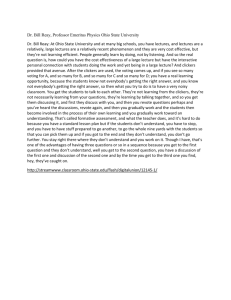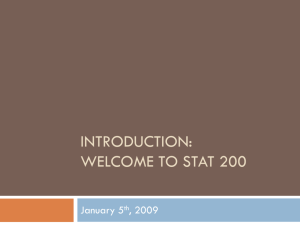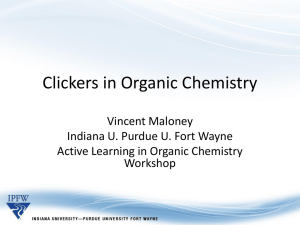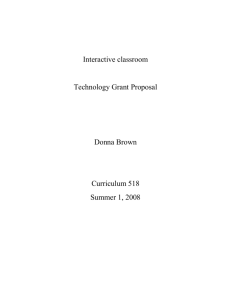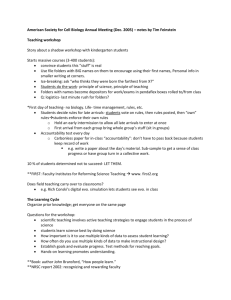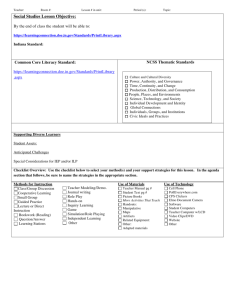How to engage students in active learning
advertisement
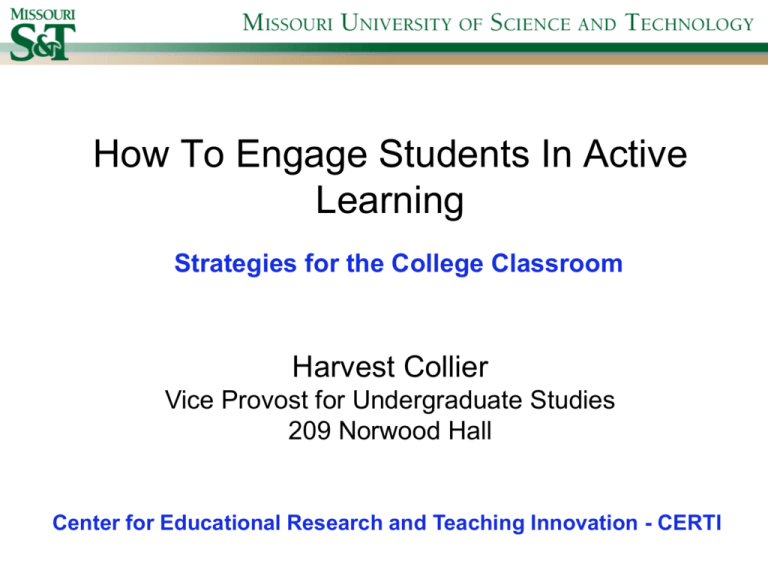
How To Engage Students In Active Learning Strategies for the College Classroom Harvest Collier Vice Provost for Undergraduate Studies 209 Norwood Hall Center for Educational Research and Teaching Innovation - CERTI Office of Undergraduate Studies Advising Office Freshman Engineering CERTI LEAD/Tutoring/JAM Physical Education RPDC SDELC Speech Communication Center Teacher Education Writing Center AGO Hit the Ground Running Critical Elements - Active/Cooperative Learning Research Supports that students need to do more than listen to learn1 A survey of U.S. professors found that lecturing is the mode of Instruction in 89% of physical scientists and mathematicians1 (1)Chickering, A., and Gamson, Z. (1987) "Seven Principles for Good Practice," AAHE Bulletin, 39:3–7, ED 282 491, 6pp, MF-01; PC-01. Descriptions of Active/Collaborative Learning •Active learning –Activities that engage students in doing something besides listening to a lecture and taking notes to help them learn and apply course material –Students may be talking or listening to one another, writing, reading, or reflecting individually •Collaborative learning –Subset of active learning –Engage students in interacting with one another •Cooperative learning –Subset of collaborative learning involving students interacting with one another under certain conditions (more structured activities) National Effective Teaching Institute (ASEE Sponsored), 1998. Descriptions of Active/Collaborative Learning "When using active learning students are engaged in more activities than just listening. They are involved in dialog, debate, writing, and problem solving, as well as higher-order thinking, e.g., analysis, synthesis, evaluation.” Bonwell, C., and Eison, J. (1991) "Active Learning: Creating Excitement in the Classroom," ASHE-ERIC Higher Education Report No. 1 Descriptions of Active/Collaborative Learning Cooperative learning is "the instructional use of small groups so that students work together to maximize their own and each other's learning. Five essential components must be present for small-group learning to be truly cooperative: 1. 2. 3. 4. 5. clear positive interdependence between students Face-to-face interaction individual accountability emphasize interpersonal and small-group skill processes must be in place for group review to improve effectiveness.” Johnson, D.W., Johnson, R.T., and Smith, K. (1991) Active Learning: Cooperation in the College Classroom, Edina, MN: Interaction Book Company Descriptions of Active Learning Seven Principles for Good Practice in Undergraduate Education* Adopted by the UM Board of Curators for the UM Strategic Action Plan A Design for the Future. As passed by the UMR Academic Council (April 17, 2003), faculty are urged to: Encourage Student-Faculty Contact Encourage Cooperation Among Students Encourage Active Learning Give Prompt, Frequent, Informative Feedback Emphasize Time on Task Communication High Expectations Respect and Encompass Diverse Talents and Learning Styles * modified slightly from the original Seven Principles article by Chickering and Gamson (1987) http://lead.mst.edu/sevenprinciples/index.html MS&T Student Expectations 74% of beginning students plan to study 6-15 hours per week 55% of beginning students expect to have a gpa between 3.5-4.0 (45% 3.00-3.49) On average 93% anticipate meeting with faculty outside of the classroom/laboratory Patty Frisbee, “2007 MS&T Entering Student Survey”, MS&T New Student Programs Office. Examples of Useful Practices ON COURSE PERSONAL RESPONSE DEVICES (Clickers) VIRTUAL LEARNING ENVIRONMENT EDUCATIONAL RESEARCH (Instructor -Student Engagement) Examples of Useful Practices ON COURSE - A Focus On Student Success COURSE OBJECTIVES: In this course, you will learn how... 1.TO TAKE CHARGE OF YOUR LIFE. You will learn how to take personal responsibility, gaining greater control over the outcomes and experiences that you create both in college and in life. 2.TO INCREASE SELF-MOTIVATION. You will learn to create greater inner motivation by discovering your own personally meaningful goals and dreams. 3.TO IMPROVE PERSONAL SELF-MANAGEMENT. You will learn numerous strategies for taking control of your time and energy, allowing you to move more effectively and efficiently toward the accomplishment of your goals and dreams. 4.TO ENHANCE RELATIONSHIPS. You will learn how to develop mutually supportive relationships that will support you to achieve your goals and dreams as you assist others to achieve theirs. 5.TO HEIGHTEN SELF-AWARENESS. You will learn how to understand and revise your self-defeating patterns of behavior, thought, and emotion as well as your unconscious limiting beliefs. Examples of Useful Practices ON COURSE OBJECTIVES: In this course, you will learn how... 6.TO MAXIMIZE LEARNING. You will learn a powerful process of learning that will enable you to get better grades in college and be an effective life-long learner. You will learn many effective study skills as well. 7.TO STRENGTHEN EMOTIONAL INTELLIGENCE. You will learn effective strategies for managing distressing emotions and increasing your inner sense of well being and happiness. 8.TO RAISE YOUR SELF-ESTEEM. You will learn how to develop self-acceptance, selfconfidence, self-respect, self-love, and unconditional self-worth. 9.TO WRITE MORE EFFECTIVELY. You will learn how to improve your writing skills through the extensive writing practice offered by your guided journal entries. 10.TO DEVELOP CREATIVE AND CRITICAL THINKING SKILLS. You will learn how to enhance the thinking skills essential for analyzing and solving problems in your academic, professional, and personal lives. 11.TO ACHIEVE GREATER SUCCESS IN YOUR CAREER. You will learn and develop the personal qualities and skills that employers identify as essential for excelling in the world of work. Examples of Useful Practices CLICKERS QuickTime™ and a TIF F ( Uncompressed) decompressor are needed to see this picture. Quick Time™a nd a TIFF ( Unco mpre ssed ) dec ompr esso r ar e nee ded to see this pictur e. Examples of Useful Practices CLICKERS Integrating Clickers into Lecture Courses Here are some basic ways to use clickers in lectures: ・Facilitate Class Discussion - Facilitate discussion by polling students' opinions and discussing the reasons for their opinions. ・Guide Lectures - Collect immediate feedback about students' understanding of lecture topics so confusion can be addressed quickly. ・Encourage Peer Instruction - Allow students to share, discuss, and change their opinions before answering a question. ・Collect Data and Perform Formative Assessment - Collect data on course topics or learning preferences throughout the cycle of a course. ・Offer Quizzes and Exams - Decrease grading time by using clickers to collect student answers to quizzes and exams. ・Take Attendance - Record attendance in large lecture courses. http://telr.osu.edu/clickers/ Examples of Useful Practices Why Use Clickers? Use of clickers in the classroom has been shown to increase students' attention and interest and to increase retention of information presented in lectures. Using clickers to pose questions that require synthesis of information, such as asking for an opinion on a complex social or ethical issue, promotes critical thinking and helps make learning personal. Additionally, clickers can ・Transform large group instruction into an active learning experience. ・Provide a "safe" way for shy students to participate in classroom discussion. ・Allow anonymous, simultaneous, and fast response to instructor questions on class material or learning preferences. ・Add a little fun to the classroom. http://telr.osu.edu/clickers/ Examples of Useful Practices VIRTUAL LEARNING ENVIRONMENT Learning Sessions by Distance Campus Resources Webx Wimba Please visit with IT to gain insight about using these resources Examples of Useful Practices EDUCATIONAL RESEARCH (Instructor -Student Engagement) It is imperative that teachers provide lectures that are as clear as possible so that students can make sense of what is being presented. Understanding allows students to retain, recall and apply material in other circumstances. Failure to understand often leads students to incorrectly interpret material or, in frustration, to ignore what has been said. In the past, many instructors believed that comprehension was entirely the students' responsibility. As we become more knowledgeable about cognitive research, however, it is apparent that much of that burden is the responsibility of the instructor as well. The question, of course, is how do we explicitly make our lectures more clear to students? Abstracted from Chilcoat, G. W. (1989). Instructional behaviors for clearer presentations in the classroom. Instructional Science, 18, pp. 289-314 Examples of Useful Practices Making Lectures More Clear to Students 1. 2. 3. 4. 5. 6. 7. 8. 9. Provide a preview of information prior to an explanation. Organize information within a step-by-step lesson sequence. Assess student learning when information is being given. Signal transitions between information. Use multiple examples to illustrate information points. Stress important points during explanations. Provide for brief pauses as appropriate times during the lecture. Eliminate additional unexplained content nonessential to current explanation. Review information frequently. Aabstracted from Chilcoat, G. W. (1989). Instructional behaviors for clearer presentations in the classroom. Instructional Science, 18, pp. 289-314 / http://www.active-learning-site.com/sum1.htm CERTI Promotion of Faculty Learning Communities Focused on Improving the Learning Environment and Student Learning Outcomes Clicker - FLC (On-going) Virtual Learning Environment (VLE) - FLC (On-going) On Course - FLC (Starting F’08) Blackboard - FLC (Starting F’08) iPOD Applications - FLC (Starting F’08) “101” Course Instructors (Starting F’08) Useful Web References Active Learning Resources http://www.acu.edu/cte/activelearning/resources.htm Active/Collaborative Learning www.foundationcoalition.org/home/ keycomponents/collaborative_learning.html On Course http://college.hmco.com/collegesurvival/downing/on_course/4e/students/index.html Clickers http://www.turningtechnologies.com/ Many Other Places to Seek Insight Websites http://www.ncsu.edu/effective_teaching/ (Felder; NCSU) http://www.asee.org https://engineering.purdue.edu/ChE/News_and_publications/teaching_engineering http://www.fie.engrng.pitt.edu http://mazur-www.harvard.edu/talks.php Many universities have course notes on-line (copyright) Books and print Silberman, Active Learning: 101 Strategies to Teach Any Subject Wankat and Oreovicz, Teaching Engineering Educational journals Workshops National Effective Teaching Institute (ASEE Sponsored) New Faculty Teaching Scholars Program ASEE Discipline Specific Activities (IEEE, ACerS, others) Networking at Technical Meetings Active Learning Resources R. W. Swartz FFF presentation, MS&T, March 2007
